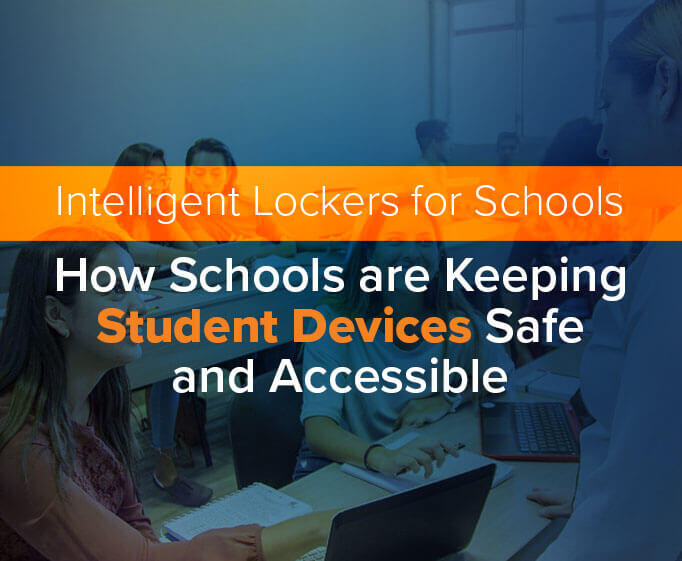By Jay Palter | June 19, 2024
Operational shutdowns, such as when a fleet vehicle breaks down, a forklift won’t start, or a handheld warehouse scanner throws a software error, can significantly impact a business's productivity and profitability. That is why maintenance teams want to track critical assets closely, monitoring their condition over time and performing preventive maintenance or emergency repairs when necessary. Without careful tracking, unplanned downtime and costs can stack up fast.
That is why many organizations use computerized maintenance management software (CMMS) to track maintenance schedules for their tools and capital assets. This can work well for some organizations, but it only tracks things that can go wrong with assets, not the assets as a whole. For example, who is using your tools? When and where? Are they punctual in returning them, or are critical pieces of equipment going missing?
A CMMS itself can’t provide that level of equipment tracking. But if you integrate a CMMS with a smart locker system, you can truly have cradle-to-grave management for all your sensitive tools, electronics, and other business equipment.
This article explores what a smart locker is, how a CMMS and a smart locker system can work together, and offers some best practices for implementing this modern management system at your company.
What is a CMMS?
A CMMS, or computerized maintenance management system, is a system that helps companies centralize maintenance information and processes with the objective of optimizing equipment uptime. Several factors are driving the adoption and advancement of CMMSs across industries. They manage work orders and help organize activities across multiple sites.
The maturity level of CMMS usage varies from company to company. Those with more mature approaches are looking for incremental gains in the standardization and efficiency of their maintenance operations. Less mature companies frequently want increased visibility into their maintenance activities. Regardless of maturity level, all companies benefit by using a CMMS to standardize and document their processes, which leads to less equipment downtime and more efficient repair cycles.
Using a CMMS is about more than managing maintenance work orders. Ultimately, a CMMS brings operations and maintenance activities closer to more seamless overall processes. They manage equipment assets and ensure maintenance meets key performance indicators (KPIs), particularly on your parts spend. Often, a CMMS is integrated into enterprise resource planning (ERP) systems and enterprise asset management (EAM) software. Increasingly, many businesses are looking to integrate them with smart locker systems for better overall management.
Learn More: Optimizing Asset Maintenance Management for Growth
What is a smart locker system?

A smart locker system is a secure storage and distribution system with an integrated computer and sensor network. This smart technology network allows the locker to monitor and manage itself, making real-time adjustments for better inventory control.
For example, smart lockers can dynamically adjust which assets are available for signout to distribute wear and tear across your entire inventory. They can flag items requiring maintenance and alert administrators to any irregularities in usage patterns.
While a traditional locker might simply store a laptop with basic PIN code security, a smart locker system offers significantly more functionality. It secures and charges the laptop and tracks who signs it out and when. Administrators can set user-specific access permissions and receive notifications if the laptop isn’t returned on time, thus enhancing security and management efficiency. All of which provide superior workforce enablement.
Core components of smart lockers
Let’s examine the components needed to make a locker system, going from the least to the most smart components.
The lockers
Durable locking cabinets are the core structure of a smart locker system. From the outside, smart lockers often resemble traditional lockers, featuring ventilated metal or clear high-impact polycarbonate doors. It is the connected systems that make these lockers smart.
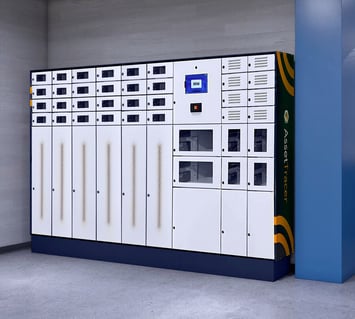
Authentication panel
The authentication panel is the primary tool that provides the ‘smarts.’ It controls access by requiring users to authenticate themselves and only unlocks the authorized equipment.
Basic authentication can be done using PIN codes. More advanced options include swipe cards, smartphone apps, and biometric scans (fingerprints, facial recognition, or iris scans), which provide higher levels of security and reduce the risk of unauthorized access.
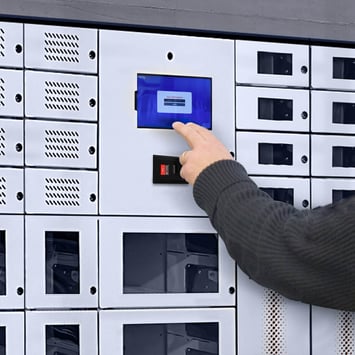
Asset surveillance
Smart lockers go beyond tracking users to monitor individual assets, a process known as asset surveillance. This is typically achieved using passive RFID tags attached to or embedded in assets. The locker system reads these tags to verify that the correct item has been taken or returned.
Additionally, lockers can use USB charging cables to perform asset surveillance. When devices like tablets and smartphones are plugged into their charging cables or cradles, their identity is related to the locker system/ This adds an important layer of accountability.
Learn More: What is Physical Asset Surveillance?
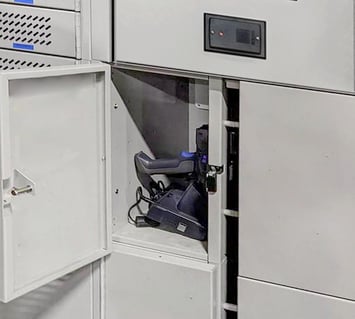
Management software
The final component is the management software, which consolidates data from the authentication panel and the surveillance system in a user-friendly dashboard. This software allows administrators to customize and review user and transaction reports, aiding in regulatory compliance and providing valuable insights into asset usage and management.
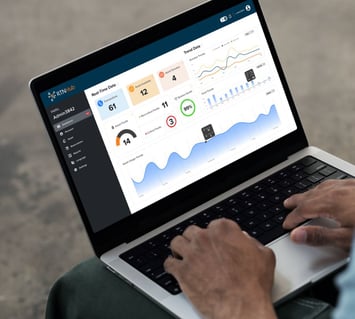
Why integrate smart lockers with a CMMS?
Connecting your CMMS to a smart locker system creates a business management platform that’s greater than the sum of its parts. Some of the key benefits you gain from this system integration include:
Data-driven decision-making
Combining smart lockers with a CMMS enables collecting and analyzing all kinds of data on asset usage, maintenance needs, and patterns in all of that activity. Smart lockers automatically log every check-in and check-out event, capturing real-time data on who accessed which equipment and when.
This data can provide valuable insights that support informed decision-making. With a clear understanding of asset utilization and wear-and-tear trends, managers can make proactive decisions to optimize maintenance schedules and equipment allocation.
Extending asset life cycles
An integrated CMMS and smart locker system can significantly extend the lifespan of your assets. The CMMS schedules preventative maintenance based on usage data, while smart lockers ensure that equipment is always available and in good condition.
Organizations can reduce the risk of unexpected breakdowns and costly repairs by automating these processes. Preventive maintenance becomes more effective when driven by accurate, real-time data from smart lockers, ensuring that assets receive the attention they need before issues arise.
Automating asset tracking
Manual tracking of tools and equipment can be time-consuming and prone to errors. Integrating smart lockers with a CMMS automates the asset check-in/check-out process, streamlining the workflow and reducing your manual administrative burden.
Employees can quickly access the tools they need by authenticating themselves at the smart locker, which then updates the CMMS with the transaction details. This automation ensures accurate records of asset movements, minimizes human error, and frees up time for more critical tasks.
Minimizing downtime
You can even configure advanced smart locker systems with specially dedicated ‘maintenance lockers.’ When users encounter a problem with a device, they can log it as damaged, and the system will unlock the dedicated compartment. It will issue a service request to the appropriate technician and only unlock for that tech’s team members so the device doesn’t accidentally go back into circulation.
Enhancing security and accountability
Smart lockers enhance security by restricting access to authorized personnel and providing detailed usage logs. Each access event is recorded, creating a robust audit trail that can be integrated into the CMMS.
This comprehensive asset management system ensures that only qualified individuals can access sensitive equipment, reducing the risk of misuse or theft. The detailed logs also support accountability, as managers can track exactly who used an asset, for how long, and for what purpose, thus deterring potential security breaches.
Best practices for integrating smart lockers with a CMMS
No matter the size or sector of your business, if you plan to integrate smart lockers with your CMMS, we recommend following a few universal best practices.
Setting clear goals is essential for the success of any major project, including integrating a CMMS with smart lockers. Then, assign a leader to oversee the process.
Decide what you want to achieve, such as providing audit reports, saving money, or knowing the exact location of assets. Once you have a goal, design the process to meet these objectives. For example, if your goal is to reduce losses of expensive tools, include a requirement for employees to provide their information and the reason for checking out a tool in your workflow. This helps identify any misuse or theft.
Begin by identifying and tracking the top 10 to 15 percent of your most essential and expensive tools. This targeted approach prevents overwhelming your system and users. Focus initially on critical items vital for daily operations. Over time, gradually incorporate additional tools into the system based on their importance and your organization's needs.
Configure the smart lockers to require authentication methods that align with your security policies, such as PIN codes, RFID cards, or biometrics, depending on the security level required for authentication in your workplace.
Ensure a seamless flow of data between the smart lockers and the CMMS. Integrating their management systems keeps records of asset usage and maintenance needs up to date, improving the accuracy and reliability of your physical asset and IT asset management.
Provide comprehensive training for employees on how to use the smart locker system and the CMMS. Proper training maximizes the benefits of the integration and ensures that staff members are comfortable and proficient with the new system.
Continuously analyze the data collected by the integrated systems. Identify trends, optimize maintenance schedules, and improve operational efficiency by making data-driven decisions. Regular reviews help you adjust and refine processes to meet your organizational goals better.
A business intelligence and management system that’s greater than the sum of its parts
Integrating smart lockers with a CMMS can revolutionize asset management practices, offering enhanced security, efficiency, and reliability. This powerful combination streamlines workflows, enabling organizations to make data-driven decisions. By leveraging these advanced systems, businesses can achieve better asset security, improve operational efficiency, and ensure greater reliability, ultimately leading to improved business outcomes.
[Download]
Ultimate Guide to Smart Lockers
Subscribe to our blog

Jay Palter
Vice President of Marketing & Partnerships

